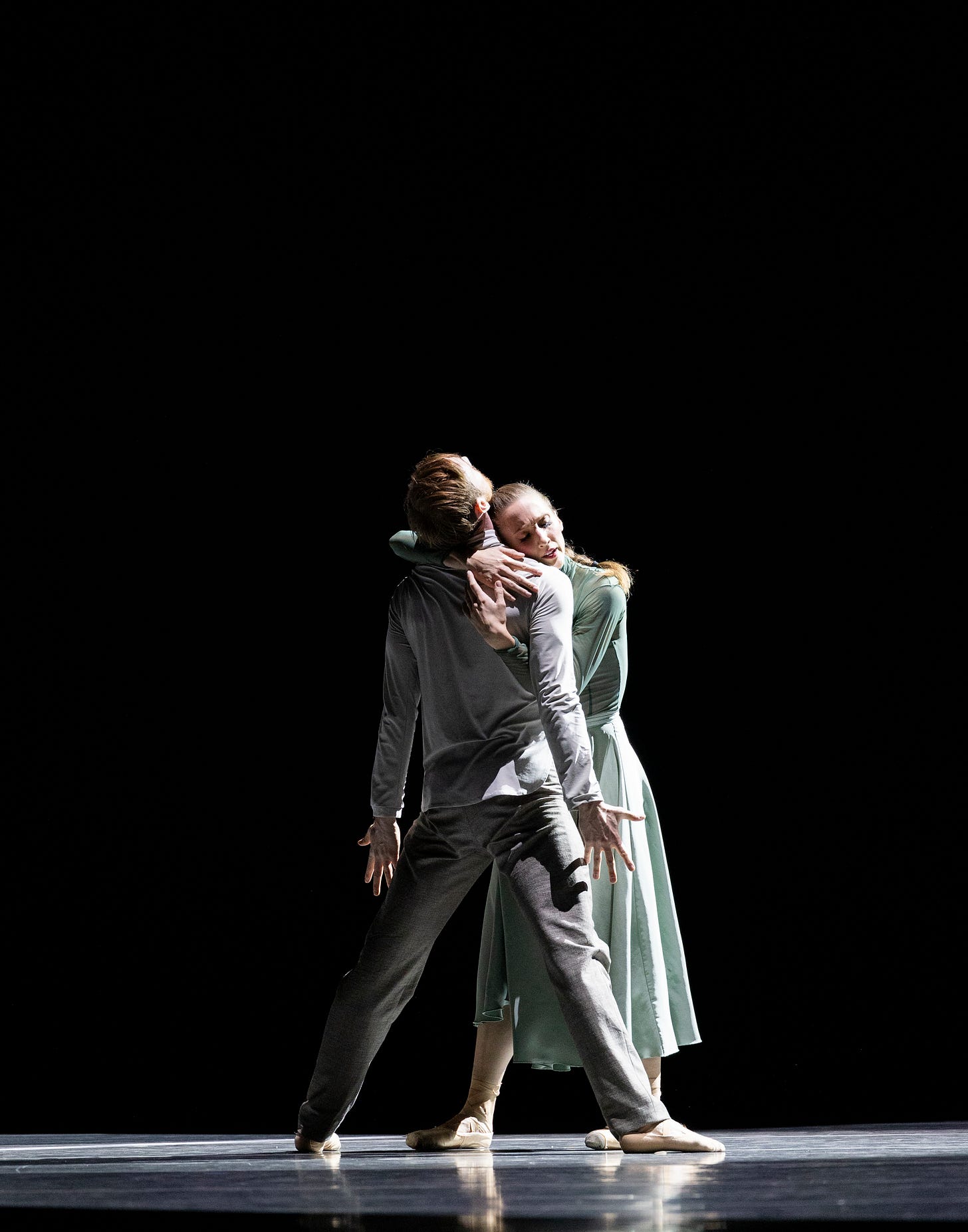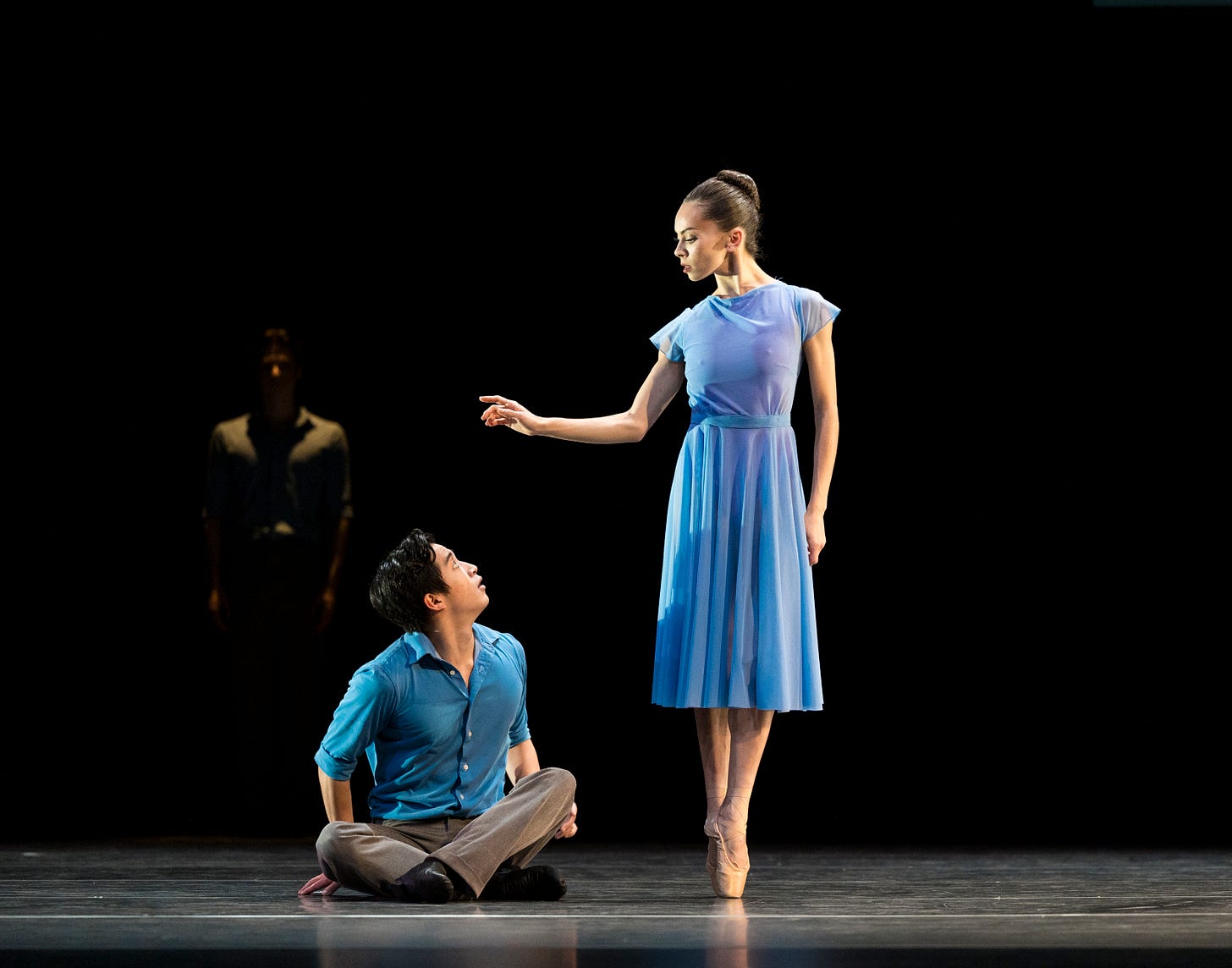Love, Loss and November
I can’t possibly be the only human who can’t separate love from loss. Or, conversely, I guess, loss from love. I’m assuming that most of us have loved and lost, or at the very least, we’ve had our wrists slapped during some type of human interaction. Sometimes harder than we expected.
That’s what I assume is behind Pacific Northwest Ballet’s latest artistic program of this, the company’s 51st artistic season. They’ve titled it “Love and Loss,’ and it covers everything from loss of life to loss of love to loss of the Ukraininan culture itself, as epitomized by choreographer Alexei Ratmansky for PNB’s 50th anniversary season last year. The company presented the reprise of Ratmansky’s piece mourning the Russian invasion of Ukraine, a seemingly endless war.

The three ballets are all relatively recent, and, befitting the grey November days that snuck in this past week, they all are tinged with a melancholy beauty. I don’t know whether or not Dani Rowe decided to honor her new region of employment (she took the artistic reins of Oregon Ballet Theater this fall) with the premier of her new dance, The Window. Either Rowe, sandwiched between Alexei Ratmansky’s 2022 poignant gem Wartime Elegy, a tender serenade to his native Ukraine, and Donald Byrd’s less overt but no less beautiful Love and Loss, set to music of the same title by Israeli composer Emmanual Wizthun, was inspired by moody gray weather or she’s prepping her psyche for her first winter here. We wish you well!
In either case, Rowe has created a mini-love triangle, I think, in which a couple, danced by principals Elizabeth Murphy and James Kirby Rogers, are surveilled by corps de ballet dancer, Melissa Guilliams who more than held her own with the two principal dancers. I think I might have to see this at least one more time to decode the nuances of the plot, as I’m not familiar with the story Rowe used as the basis for her ballet. I can say that Rowe’s ballet fits nicely, if a tad one-note-ish, on this somber bill.
Artistic Director Peter Boal writes in the program that the performance is a fitting counterpart to the Nutcracker, opening the week of November 20th. While the November reps usually do offer audiences an array of contemporary works, and I do mean array, this show is a bit unusual in that it offers three variations on a theme of “moody.” It might be a little downbeat, but for me, after 30 years in Seattle, it feels just right for the season.
While Ratmansky’s Wartime Elegy and Byrd’s Love and Loss are the tent poles for this program, Byrd’s ballet is structurally more complex and aspires to a more universal message. And if it’s not exactly celebratory, there’s some fine dancing to be seen, especially by the men in the cast.
An abstract rumination on the fickleness of human relationships, Love and Loss is both touching in terms of how it depicts the ways we interact, and searing in its portrayal of how we reveal our frailties to one another.

The dancers are served particularly well by Byrd’s choreography. They look engaged and ready for anything, something I also recognized when this dance premiered in 2019. One of Byrd’s fine skills is to make his dancers look their best; maybe I’m reading too much into a single performance, but it feels as if the dancers are giving their all to Byrd, and in turn to us.
Ratmansky also depicted human interactions in Wartime Elegy, but in response to a devastating war that aims to dismantle the Ukrainian culture rather than a simple relationship. I was fortunate to be in the house on the occasion of this ballet’s premiere last season, and I don’t think I’ve ever seen a more heart felt debut. Ratmansky clearly dispatched this work like a cry that held both joy and pain. It was a privilege to be at the debut but it was equally enjoyable to see it again.
Rowe’s new work, while centered on big emotions (what’s bigger than love and hate and sorrow??) seemed slighter than the other two ballets, even with a death enclosed. Not that the dancers (James Kirby-Rogers, Elizabeth Murphy and Melissa Guilliams) weren’t excellent, just working with less ambitious material. Of course, I’ve had the advantage of seeing the Ratmansky and the Byrd a few more times than Rowe’s ballet. Maybe with multiple viewings, it will burrow its way into my psyche, too.
The program actually began before a single step was danced.
November is usually when Boal announces company promotions and three well-deserving dancers rose up the ranks. Both Clara Ruf Maldonado and Kuu Sakuragi were elevated to soloists. Frequently partnered, the two dancers share a light, lilting style that seems to belie the difficulty of what they’re doing. I always enjoy watching them onstage together (and apart).
New principal dancer Sarah-Gabrielle Ryan has an uncanny ability to completely embody whatever role she’s performing. And while it might feel like a cheap shot to talk about Ryan’s falls in past performances, I mean it as a high compliment. I love to watch a dancer—any artist really—throw herself into a performance so fully that she lets go of any fear of mistakes, even of looking foolish. Ryan goes for broke, and has done so since she first arrived at PNB. It’s one of the most delightful things about her: she just goes all out. Bravo!
As I think back on Love and Loss, the program, I return to how very autumnal it felt, how very Pacific Northwest. It was beautiful, sad, poignant. Pretty much any adjective you could use to describe November.
The three ballets dripped like damp leaves. If there was a melancholy to the overall program, it was no less beautiful for its lack of cheer, but definitely a little soggy. I sometimes wonder if that’s what separates true Pacific Northwest lovers from those who never quite settle into this place. All newcomers are faced with a choice: adapt or perish. Until we embrace both the losses and the loves, the sun and the long months of rain, we never really bond with the community, with the region.
Ratmansky showed us with his piece that we’re more than open to works about different places, or people, or times. What we’re really hungry for is strong work. While somber, the Love and Loss program delivered.
Love and Loss runs through Sunday November 12 at McCaw Hall.






